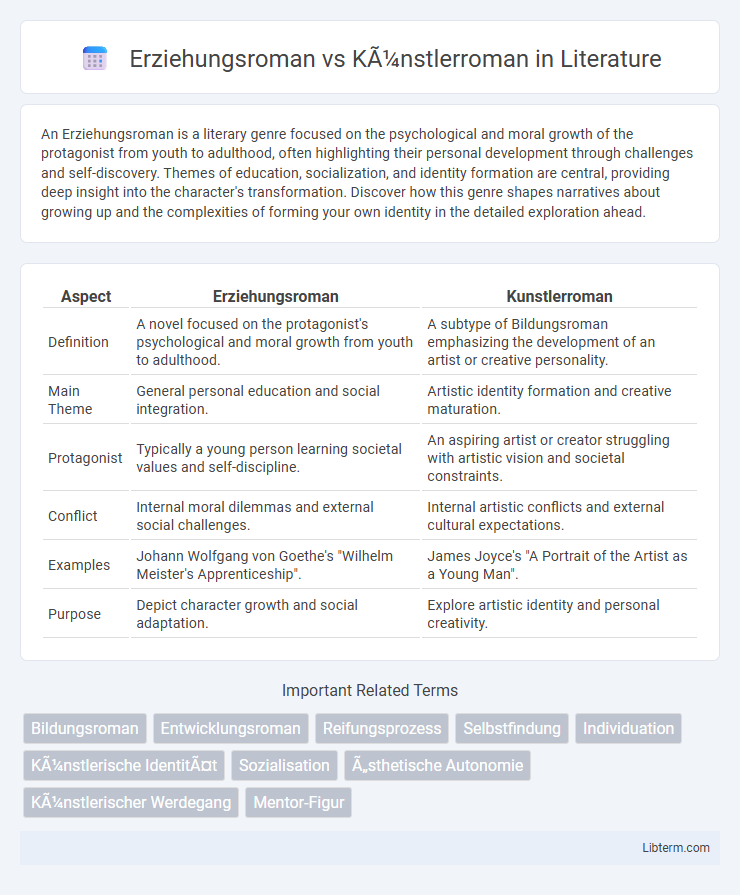An Erziehungsroman is a literary genre focused on the psychological and moral growth of the protagonist from youth to adulthood, often highlighting their personal development through challenges and self-discovery. Themes of education, socialization, and identity formation are central, providing deep insight into the character's transformation. Discover how this genre shapes narratives about growing up and the complexities of forming your own identity in the detailed exploration ahead.
Table of Comparison
| Aspect | Erziehungsroman | Kunstlerroman |
|---|---|---|
| Definition | A novel focused on the protagonist's psychological and moral growth from youth to adulthood. | A subtype of Bildungsroman emphasizing the development of an artist or creative personality. |
| Main Theme | General personal education and social integration. | Artistic identity formation and creative maturation. |
| Protagonist | Typically a young person learning societal values and self-discipline. | An aspiring artist or creator struggling with artistic vision and societal constraints. |
| Conflict | Internal moral dilemmas and external social challenges. | Internal artistic conflicts and external cultural expectations. |
| Examples | Johann Wolfgang von Goethe's "Wilhelm Meister's Apprenticeship". | James Joyce's "A Portrait of the Artist as a Young Man". |
| Purpose | Depict character growth and social adaptation. | Explore artistic identity and personal creativity. |
Definition of Erziehungsroman
Erziehungsroman is a literary genre that focuses on the psychological and moral growth of the protagonist from youth to adulthood, often highlighting personal development through education and life experiences. It emphasizes the character's internal conflicts and societal challenges as they strive to find their identity and place within the world. Unlike Kunstlerroman, which centers specifically on the development of an artist and their creative maturation, Erziehungsroman covers a broader spectrum of personal growth beyond artistic pursuits.
Definition of Künstlerroman
Kunstlerroman is a literary genre that specifically focuses on the development of an artist's character, exploring their creative growth and struggles within the broader framework of personal maturation. Unlike Erziehungsroman, which centers on general education and moral development, Kunstlerroman delves into the psychological and artistic evolution of the protagonist as they discover and refine their artistic identity. This genre highlights the tension between individual creativity and societal expectations, portraying the artist's journey toward self-realization and artistic fulfillment.
Historical Origins and Development
The Erziehungsroman, emerging prominently in 18th-century German literature, focuses on the protagonist's moral and psychological growth within society, exemplified by works like Goethe's "Wilhelm Meister's Apprenticeship." The Kunstlerroman, a subgenre of the Bildungsroman, specifically centers on the development of an artist's creative identity and struggles, gaining prominence in 19th-century Romantic and Modernist periods with authors like Thomas Mann in "Tonio Kroger." Both genres evolved from Enlightenment ideas about individual formation but diverged as the Kunstlerroman emphasized the unique conflicts of artistic vocation and expression.
Core Themes in Erziehungsroman
Core themes in an Erziehungsroman revolve around personal growth, moral development, and the protagonist's journey toward self-awareness within societal contexts. This genre emphasizes the challenges of education, identity formation, and the reconciliation of individual desires with social expectations. Unlike the Kunstlerroman, which centers on artistic development, the Erziehungsroman broadly addresses psychological and ethical maturation.
Core Themes in Künstlerroman
Kunstlerroman centers on the development of an artist's identity, exploring themes of creativity, self-discovery, and the struggle for artistic expression. This genre delves into the conflict between societal expectations and the artist's pursuit of authenticity, often highlighting isolation and personal growth. Core themes include the transformation of raw talent into mastery, the role of inspiration, and the tension between individual vision and external pressures.
Notable Examples of Erziehungsroman
Notable examples of Erziehungsroman include Goethe's "Wilhelm Meister's Apprenticeship," which explores the protagonist's personal development and social integration. Charles Dickens' "Great Expectations" similarly traces the coming-of-age journey and moral growth of Pip. These works exemplify the Erziehungsroman's focus on psychological and moral maturation, distinguishing it from the Kunstlerroman that centers more on the artist's creative development.
Notable Examples of Künstlerroman
Notable examples of Kunstlerroman include Johann Wolfgang von Goethe's "Wilhelm Meister's Apprenticeship," which explores the development of an artist's identity and creative consciousness. James Joyce's "A Portrait of the Artist as a Young Man" offers a profound examination of artistic self-discovery and rebellion against societal norms. Thomas Mann's "Tonio Kroger" provides insight into the psychological struggles of an artist torn between bourgeois life and creative passion, epitomizing the Kunstlerroman genre.
Comparative Analysis: Structure and Motifs
Erziehungsroman centers on the protagonist's psychological and moral growth, unfolding through formative life experiences and social integration, whereas Kunstlerroman emphasizes the development of an artist's creative identity and the struggle for self-expression. Common motifs in Erziehungsroman include education, mentorship, and societal norms, while Kunstlerroman often features artistic inspiration, alienation, and the conflict between individual vision and external expectations. Structurally, Erziehungsroman typically follows a linear maturation process, contrasting with the often nonlinear, episodic journey reflecting the evolving artistic consciousness in Kunstlerroman.
Impact on Literary Tradition
Erziehungsroman, centered on the protagonist's psychological and moral growth, deeply influenced the literary tradition by establishing a narrative framework for exploring individual development within societal contexts. Kunstlerroman, as a subgenre focusing on the artist's formative journey and creative struggles, enriched literary tradition by highlighting the tensions between personal artistic identity and external expectations. Together, these genres expanded thematic complexity in literature, shaping character development and narrative structure across subsequent works.
Modern Adaptations and Evolution
Modern adaptations of the Erziehungsroman often emphasize psychological complexity and multicultural identities, reflecting contemporary social dynamics and global influences. Kunstlerroman narratives have evolved to explore diverse artistic fields beyond traditional forms, incorporating digital art and multimedia storytelling to depict the artist's journey. Both genres increasingly challenge classical linear progression, favoring fragmented, non-linear structures that mirror modern experiences of growth and creativity.
Erziehungsroman Infographic

 libterm.com
libterm.com